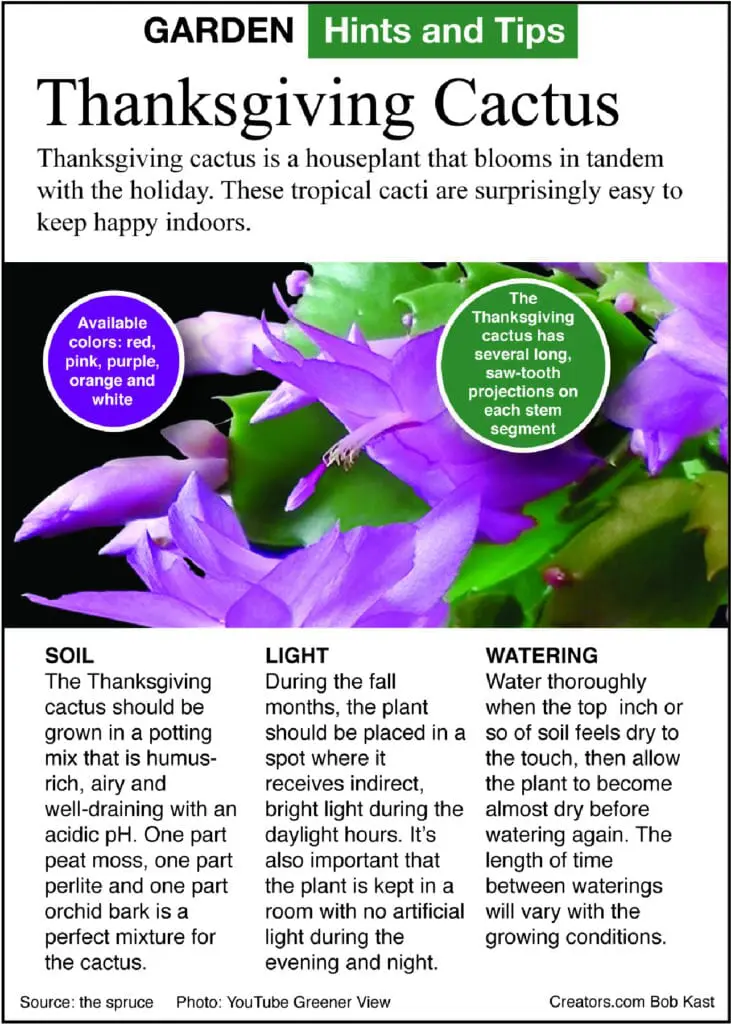Search Posts
Recent Posts
- Real Estate in RI: Seaside waterfront communities are all the rage. Who’s buying – Emilio DiSpirito June 6, 2025
- Outdoors in RI: 2A votes, Charter Yachts, active summer programs, garden tours, aquatic weeds… June 6, 2025
- All About Home Care, with two Rhode Island locations, closing after 22 years in business June 6, 2025
- GriefSPEAK: Angel wings with footprints – Mari Nardolillo Dias June 6, 2025
- Rhode Island Weather for June 6, 2025 – Jack Donnelly June 6, 2025
Categories
Subscribe!
Thanks for subscribing! Please check your email for further instructions.

A Greener View: Ready for the Thanksgiving Cactus – Jeff Rugg
by Jeff Rugg, contributing writer
You will see poinsettias soon popping up everywhere this time of year, and if you are tired of them you might want to try the easy-to-grow Thanksgiving cactus. You probably have heard them be called Christmas cacti. There are three species of similar tropical cacti. One blooms in the fall, one in the winter and one in the spring. They are named after the three holidays of Thanksgiving, Christmas and Easter.
The Thanksgiving cactus is actually the most common one sold, even for Christmas. To tell all of them apart, look at the flattened stem. It is not a leaf, but that’s what it looks like. These cacti do not have any leaves. The Thanksgiving cactus has several long saw-tooth projections on the edge of each stem segment. The true Christmas cactus usually has four rounded bumps on each stem segment. The Easter cactus has four to six wavy scallops on the edge. On all the species, the ends of the stems can have some small cactus spines.
The flowers of most Thanksgiving cacti have yellow pollen, and the flowers of most Christmas cacti have pink pollen. The flowers of Easter cacti are tube shaped, so they look different than the other two.
They are not true cacti and should not be allowed to dry out like a typical desert cactus. In nature, they are like many bromeliads because they are epiphytic plants that grow on trees and other plants in South America. Epiphytes grow along branches without taking any nutrition from their host plant.
They make great houseplants because they are very long-lived and very disease and insect resistant. They do well with minimal care and even seem to bloom better if left to become root-bound in the pot. The best way to buy them is when they are covered in buds with a few full flowers. If too many flowers are almost done blooming, you won’t get much of a display.
Flowers are formed on the ends of the branches where the main vein hits the end of the line. Sometimes there is only a single bud and sometimes there is a cluster of several. The flowers have a series of petals that form a tube about three inches long. They can be red, pink, purple, orange and white. Easter cacti have a more limited selection of colors in the red and pink range.

Cool fall temperatures and shortening day lengths in the fall will induce the Thanksgiving and Christmas cacti into bloom. The Thanksgiving cactus will bloom between November and the New Year. Christmas cacti bloom December through March. If these cacti are grown in a warm room (above 65 degrees) that has plenty of evening lighting, they may not bloom. Give them about six weeks of being moved to a cool, dark room or closet each evening and they will set buds. Kept in a room that is always around 55 degrees, they may bloom without a short day length. Easter cacti will bloom if they receive cool temperatures under 65 and the lighting does not matter.
In the wild, the soil on a tree branch is made up of loose organic matter. In a flowerpot, they can grow in an African violet mix that is sold in bags or in an orchid mixture of bark pieces, peat moss and a little potting soil. Even though they are called cacti, do not use a cactus planting mix. Keep the soil moist except when forcing them to bloom and fertilize monthly during the summer using a blossom-promoting fertilizer. They can be moved to an outdoor shady location during the summer. The best time to repot them is any time they are not setting buds or blooming. Let them get really pot bound before moving them up one pot size. They can be potted in clay or plastic, and the best pot is a hanging basket.
Keep the soil a bit on the dry side while the flower buds are forming. After you can see the tiny buds, you can go back to the normal lighting and watering.
Being from South America and growing on trees may lead you to think they need to be in full sun. They do need bright light all year long, but they can get sunburned if they are moved to a full-sun location. An east window or near a south or west window will be bright enough.
To watch a time lapse video of a Thanksgiving cactus flower opening set to the music of “Wind Beneath My Wings,” go to the Greener View YouTube channel.
To read more columns on gardening by Jeff, go to: https://rinewstoday.com/?s=jeff+rugg

Email questions to Jeff Rugg at info@greenerview.com. COPYRIGHT 2024 JEFF RUGG
Email questions to Jeff Rugg at info@greenerview.com. To find out more about Jeff Rugg and read features by other Creators Syndicate writers and cartoonists, visit the Creators Syndicate website at www.creators.com.
